Brealey, Myers. Principles of Corporate Finance. 7th edition
Подождите немного. Документ загружается.

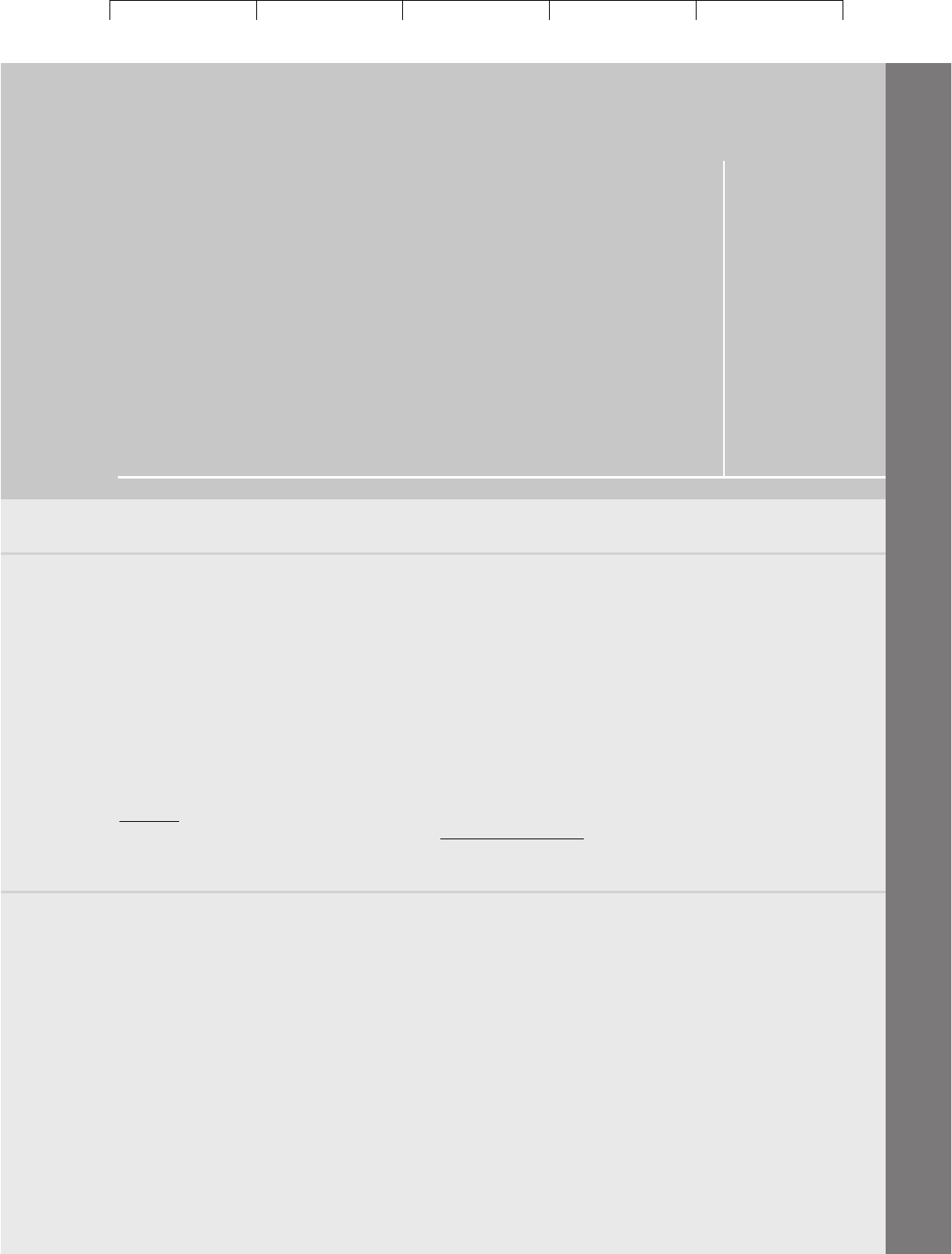
Brealey−Meyers:
Principles of Corporate
Finance, Seventh Edition
VI. Options 20. Understanding Options
© The McGraw−Hill
Companies, 2003
CHAPTER 20 Understanding Options 583
2. You do not have to pay the exercise price until you decide to exercise the option.
Therefore, an option gives you a free loan. The higher the rate of interest and the
longer the time to maturity, the more this free loan is worth. Therefore the value
of an option increases with the interest rate and time to maturity.
3. If the price of the asset falls short of the exercise price, you won’t exercise the
option. You will, therefore, lose 100 percent of your investment in the option
no matter how far the asset depreciates below the exercise price. On the other
hand, the more the price rises above the exercise price, the more profit you will
make. Therefore the option holder does not lose from increased volatility if
things go wrong, but gains if they go right. The value of an option increases
with the variance per period of the stock return multiplied by the number of
periods to maturity.
Always remember that an option written on a risky (high-variance) asset is
worth more than an option on a safe asset. It’s easy to forget, because in most other
financial contexts increases in risk reduce present value.
FURTHER
READING
The classic articles on option valuation are:
F. Black and M. Scholes: “The Pricing of Options and Corporate Liabilities,” Journal of Polit-
ical Economy, 81:637–654 (May–June 1973).
R. C. Merton: “Theory of Rational Option Pricing,” Bell Journal of Economics and Management
Science, 4:141–183 (Spring 1973).
There are also a number of good texts on option valuation. They include:
J. Hull: Options, Futures and Other Derivatives, 5th ed., Prentice-Hall, Inc., Englewood Cliffs,
NJ, 2003.
R. Jarrow and S. Turnbull: Derivative Securities, 2nd ed., South-Western College Publishing,
Cincinnati, OH, 1999.
M. Rubinstein: Derivatives: A PowerPlus Picture Book, 1998.
17
17
This book is published by the author and is listed on www.in-the-money.com.
QUIZ
1. Complete the following passage:
A ____ option gives its owner the opportunity to buy a stock at a specified price which
is generally called the ____ price. A ____ option gives its owner the opportunity to sell
stock at a specified price. Options that can be exercised only at maturity are called ____
options.
The common stock of firms that borrow is a ____ option. Stockholders effectively sell
the firm’s ____ to ____ , but retain the option to buy the ____ back. The exercise price is
the ____.
2. Note Figure 20.13. Match each diagram, (a) and (b), with one of the following positions:
• Call buyer
• Call seller
• Put buyer
• Put seller
Visit us at www.mhhe.com/bm7e
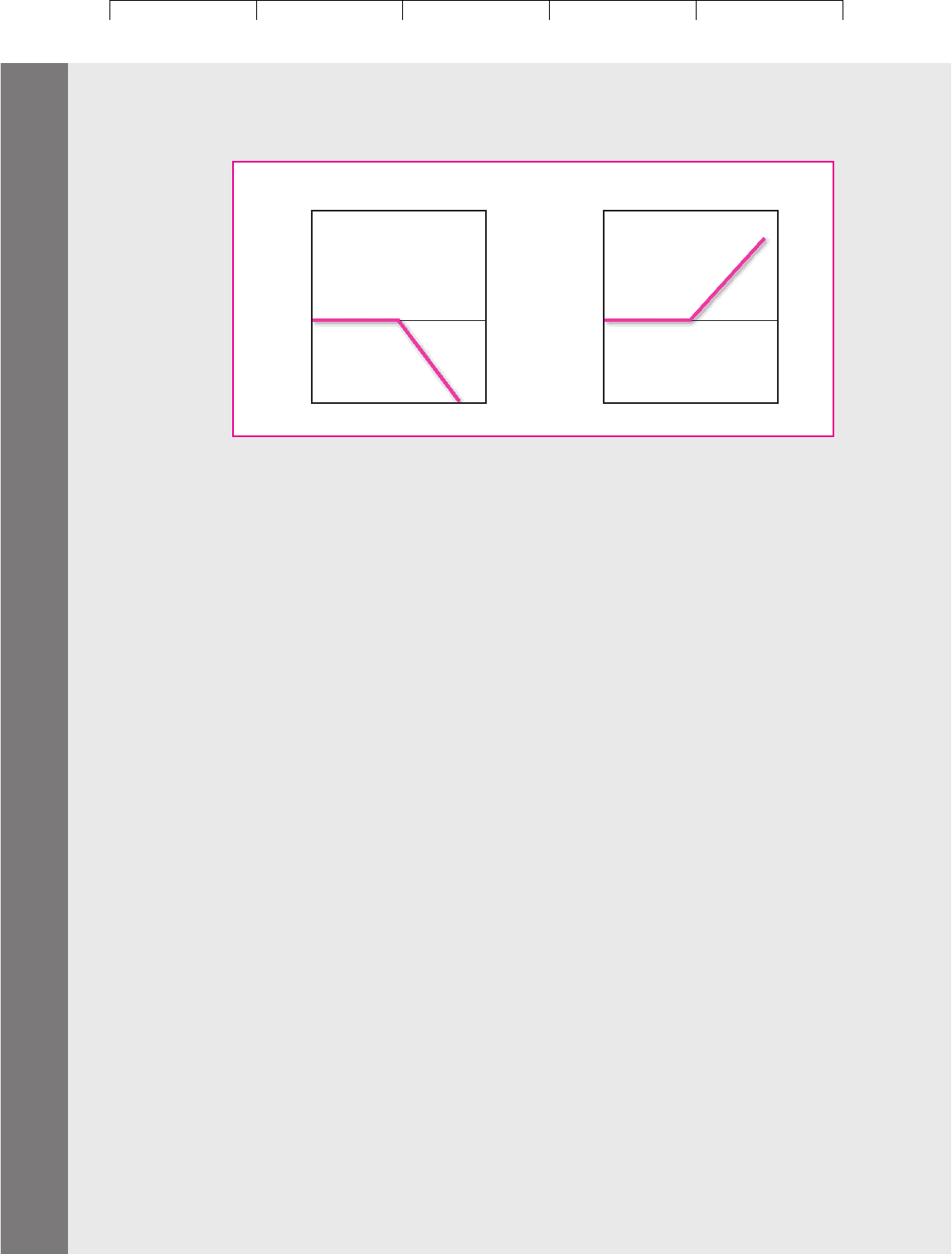
Brealey−Meyers:
Principles of Corporate
Finance, Seventh Edition
VI. Options 20. Understanding Options
© The McGraw−Hill
Companies, 2003
584 PART VI Options
Visit us at www.mhhe.com/bm7e
3. Suppose that you hold a share of stock and a put option on that share. What is the pay-
off when the option expires if (a) the stock price is below the exercise price? (b) the stock
price is above the exercise price?
4. What is put–call parity and why does it hold? Could you apply the parity formula to a
call and put with different exercise prices?
5. There is another strategy involving calls and borrowing and lending that gives the same
payoffs as the strategy described in question 3. What is the alternative strategy?
6. Dr. Livingstone I. Presume holds £600,000 in East African gold stocks. Bullish as he is
on gold mining, he requires absolute assurance that at least £500,000 will be available
in six months to fund an expedition. Describe two ways for Dr. Presume to achieve this
goal. There is an active market for puts and calls on East African gold stocks, and the
rate of interest is 6 percent per year.
7. Suppose you buy a one-year European call option on Wombat stock with an exercise
price of $100 and sell a one-year European put option with the same exercise price. The
current stock price is $100, and the interest rate is 10 percent.
a. Draw a position diagram showing the payoffs from your investments.
b. How much will the combined position cost you? Explain.
8. Explain why the common stock of a firm that borrows is a call option. What is the un-
derlying asset? What is the exercise price?
9. What does “default put” mean? When are default puts most important?
10. What is the lower bound to the price of a call option? If the price of a European call op-
tion were below the lower bound, how could you make a sure-fire profit? What is the
upper bound to the price of a call option?
11. Look again at Figure 20.13. It appears that the call buyer in panel (b) can’t lose and the
call seller in panel (a) can’t win. Is that correct? Explain. Hint: Draw a profit diagram for
each panel.
12. What is a call option worth if (a) the stock price is zero? (b) the stock price is extremely
high relative to the exercise price?
13. How does the price of a call option respond to the following changes, other things
equal? Does the call price go up or down?
a. Stock price increases.
b. Exercise price is increased.
c. Risk-free rate increases.
d. Expiration date of the option is extended.
Value of investment
at maturity
Value of investment
at maturity
(
a
)(
b
)
0
Stock
price
0
Stock
price
FIGURE 20.13
See Quiz question 2.
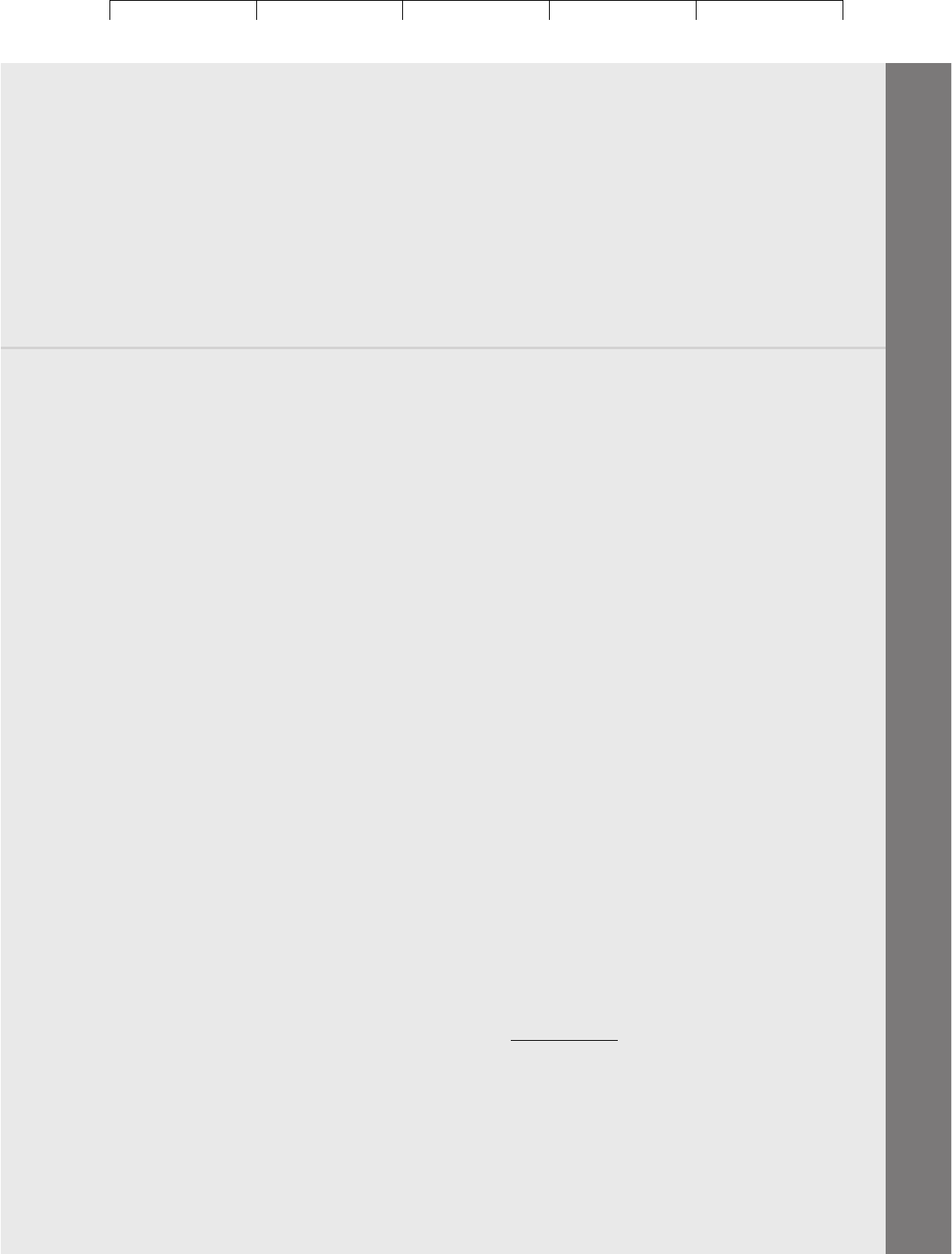
Brealey−Meyers:
Principles of Corporate
Finance, Seventh Edition
VI. Options 20. Understanding Options
© The McGraw−Hill
Companies, 2003
CHAPTER 20 Understanding Options 585
Visit us at www.mhhe.com/bm7e
e. Volatility of the stock price falls.
f. Time passes, so the option’s expiration date comes closer.
14. Respond to the following statements.
a. “I’m a conservative investor. I’d much rather hold a call option on a safe stock like
Exxon Mobil than a volatile stock like AOL Time Warner.”
b. “When a company lands in financial distress, stockholders are better off if the
financial manager shifts to safer assets and operating strategies.”
PRACTICE
QUESTIONS
1. In everyday speech the term option often just means “choice,” whereas in finance it
refers specifically to the right to buy or sell an asset in the future on terms that are fixed
today. Which of the following are the odd statements out? Are the options involved in
the other statements puts or calls?
a. “The preferred stockholders in Chrysalis Motors have the option to redeem their
shares at par value after 2009.”
b. “What I like about Toit à Porcs is its large wine list. You have the option to choose
from over 100 wines.”
c. “I don’t have to buy IBM stock now. I have the option to wait and see if the stock
price goes lower over the next month or two.”
d. “By constructing an assembly plant in Mexico, Chrysalis Motors gave itself the
option to switch a substantial proportion of its production to that country if the
dollar should appreciate in the future.”
2. Discuss briefly the risks and payoffs of the following positions:
a. Buy stock and a put option on the stock.
b. Buy stock.
c. Buy call.
d. Buy stock and sell call option on the stock.
e. Buy bond.
f. Buy stock, buy put, and sell call.
g. Sell put.
3. “The buyer of the call and the seller of the put both hope that the stock price will rise.
Therefore the two positions are identical.” Is the speaker correct? Illustrate with a posi-
tion diagram.
4. Pintail’s stock price is currently $200. A one-year American call option has an exercise
price of $50 and is priced at $75. How would you take advantage of this great oppor-
tunity? Now suppose the option is a European call. What would you do?
5. It is possible to buy three-month call options and three-month puts on stock Q. Both op-
tions have an exercise price for $60 and both are worth $10. Is a six-month call with an
exercise price of $60 more or less valuable than a similar six-month put? Hint: Use
put–call parity.
6. In June 2001 a six-month call on Intel stock, with an exercise price of $22.50, sold for
$2.30. The stock price was $27.27. The risk-free interest rate was 3.9 percent. How much
would you be willing to pay for a put on Intel stock with the same maturity and exer-
cise price?
7. Go to the Chicago Board Options Exchange website at www
.cboe.com. Check out the
delayed quotes for AOL Time Warner for different exercise prices and maturities.
a. Confirm that higher exercise prices mean lower call prices and higher put prices.
b. Confirm that longer maturity means higher prices for both puts and calls.
c. Choose an AOL put and call with the same exercise price and maturity. Confirm
that put–call parity holds (approximately). Note: You will have to use an up-to-date
risk-free interest rate.

Brealey−Meyers:
Principles of Corporate
Finance, Seventh Edition
VI. Options 20. Understanding Options
© The McGraw−Hill
Companies, 2003
586 PART VI Options
Visit us at www.mhhe.com/bm7e
8. The Rank and File Company is considering a rights issue to raise $50 million (see Chap-
ter 15 Appendix A). An underwriter offers to “stand by” (i.e., to guarantee the success
of the issue by buying any unwanted stock at the issue price). The underwriter’s fee is
$2 million.
a. What kind of option does Rank and File acquire if it accepts the underwriter’s
offer?
b. What determines the value of the option?
9. FX Bank has succeeded in hiring ace foreign exchange trader, Lucinda Cable. Her re-
muneration package reportedly includes an annual bonus of 20 percent of the profits
that she generates in excess of $100 million. Does Ms. Cable have an option? Does it pro-
vide her with the appropriate incentives?
10. Suppose that Mr. Colleoni borrows the present value of $100, buys a six-month put op-
tion on stock Y with an exercise price of $150, and sells a six-month put option on Y with
an exercise price of $50.
a. Draw a position diagram showing the payoffs when the options expire.
b. Suggest two other combinations of loans, options, and the underlying stock that
would give Mr. Colleoni the same payoffs.
11. Which one of the following statements is correct?
a. Value of put present value of exercise price value of call share price.
b. Value of put share price value of call present value of exercise price.
c. Value of put share price present value of exercise price value
of call.
d. Value of put value of call share price present value of exercise price.
The correct statement equates the value of two investment strategies. Plot the payoffs
to each strategy as a function of the stock price. Show that the two strategies give
identical payoffs.
12. Test the formula linking put and call prices by using it to explain the relative prices of
traded puts and calls. (Note that the formula is exact only for European options. Most
traded puts and calls are American.)
13. a. If you can’t sell a share short, you can achieve exactly the same final payoff by a com-
bination of options and borrowing or lending. What is this combination?
b. Now work out the mixture of stock and options that gives the same final payoff as
a risk-free loan.
14. The common stock of Triangular File Company is selling at $90. A 26-week call option
written on Triangular File’s stock is selling for $8. The call’s exercise price is $100. The
risk-free interest rate is 10 percent per year.
a. Suppose that puts on Triangular stock are not traded, but you want to buy one.
How would you do it?
b. Suppose that puts are traded. What should a 26-week put with an exercise price of
$100 sell for?
15. Digital Organics has 10 million outstanding shares trading at $25 per share. It also has
a large amount of debt outstanding, all coming due in one year. The debt pays interest
at 8 percent. It has a par (face) value of $350 million, but is trading at a market value of
only $280 million. The one-year risk-free interest rate is 6 percent.
a. Write out the put–call parity formula for Digital Organics’ stock, debt, and
assets.
b. What is the value of the default put given up by Digital Organics’ creditors?
16. Option traders often refer to “straddles” and “butterflies.” Here is an example of each:
• Straddle: Buy call with exercise price of $100 and simultaneously buy put with
exercise price of $100.
• Butterfly: Simultaneously buy one call with exercise price of $100, sell two calls
with exercise price of $110, and buy one call with exercise price of $120.
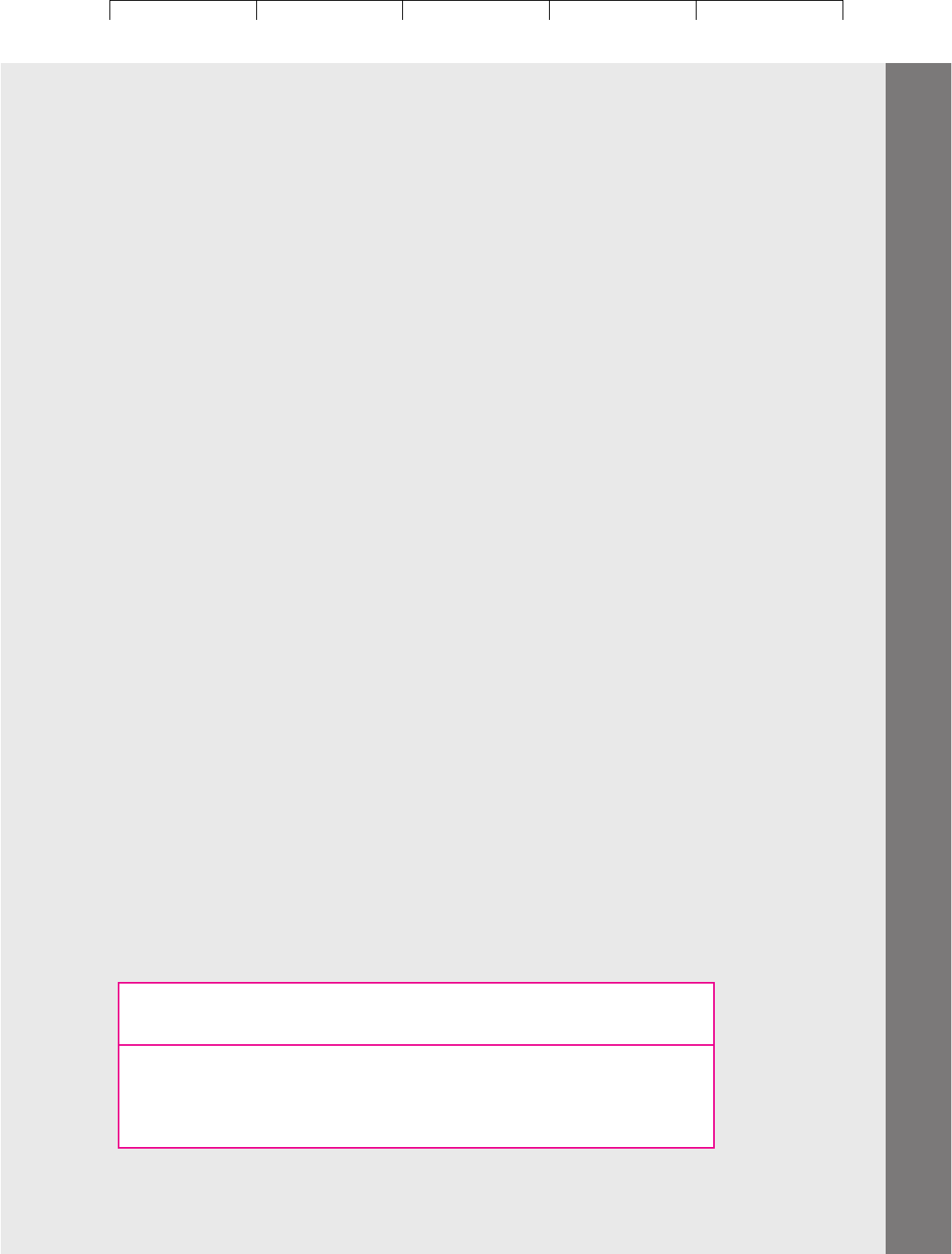
Brealey−Meyers:
Principles of Corporate
Finance, Seventh Edition
VI. Options 20. Understanding Options
© The McGraw−Hill
Companies, 2003
CHAPTER 20 Understanding Options 587
Visit us at www.mhhe.com/bm7e
Draw position diagrams for the straddle and butterfly, showing the payoffs from the in-
vestor’s net position. Each strategy is a bet on variability. Explain briefly the nature of
each bet.
17. Refer again to the Circular File balance sheet in Section 20.2. Suppose that the govern-
ment suddenly offers to guarantee the $50 principal payment due bondholders next
year and also to guarantee the interest payment. (In other words, if firm value falls short
of the promised payments, the government will make up the difference.) This offer is a
complete surprise to everyone. The government asks nothing in return, and so its offer
is cheerfully accepted.
a. Suppose that the promised interest rate on Circular’s debt is 10 percent. The rate
on one-year United States government notes is 8 percent. How will the guarantee
affect bond value?
b. The guarantee does not affect the value of Circular stock. Why? (Note: There could
be some effect if the guarantee allows Circular to avoid costs of financial distress or
bankruptcy. See Section 18.3.)
c. How will the value of the firm (debt plus equity) change?
Now suppose that the government offers the same guarantee for new debt issued by
Rectangular File Company. Rectangular’s assets are identical to Circular’s, but Rectan-
gular has no existing debt. Rectangular accepts the offer and uses the proceeds of a
$50 debt issue to repurchase or retire stock.
Will Rectangular stockholders gain from the opportunity to issue the guaranteed
debt? By how much, approximately? (Ignore taxes.)
18. Look at actual trading prices of call options on stocks to check whether they behave as
the theory presented in this chapter predicts. For example,
a. Follow several options as they approach maturity. How would you expect their
prices to behave? Do they actually behave that way?
b. Compare two call options written on the same stock with the same maturity but
different exercise prices.
c. Compare two call options written on the same stock with the same exercise price
but different maturities.
19. Is it more valuable to own an option to buy a portfolio of stocks or to own a portfolio
of options to buy each of the individual stocks? Say briefly why.
20. Table 20.4 lists some prices of options on common stocks (prices are quoted to the near-
est dollar). The interest rate is 10 percent a year. Can you spot any mispricing? What
would you do to take advantage of it?
21. As manager of United Bedstead you own substantial executive stock options. These en-
title you to buy the firm’s shares during the next five years at a price of $100 a share.
The plant manager has just outlined two alternative proposals to reequip the plant.
Both proposals have the same net present value, but one is substantially riskier than the
other. At first you are undecided about which to choose, but then you remember your
stock options. How might these influence your choice?
Time to
Exercise Exercise Stock Put Call
Stock (months) Price Price Price Price
Drongo Corp. 6 50 80 20 52
Ragwort, Inc. 6 100 80 10 15
Wombat Corp. 3 40 50 7 18
64050517
65050810
TABLE 20.4
Prices of options on
common stocks (in
dollars). See Practice
Question 20.
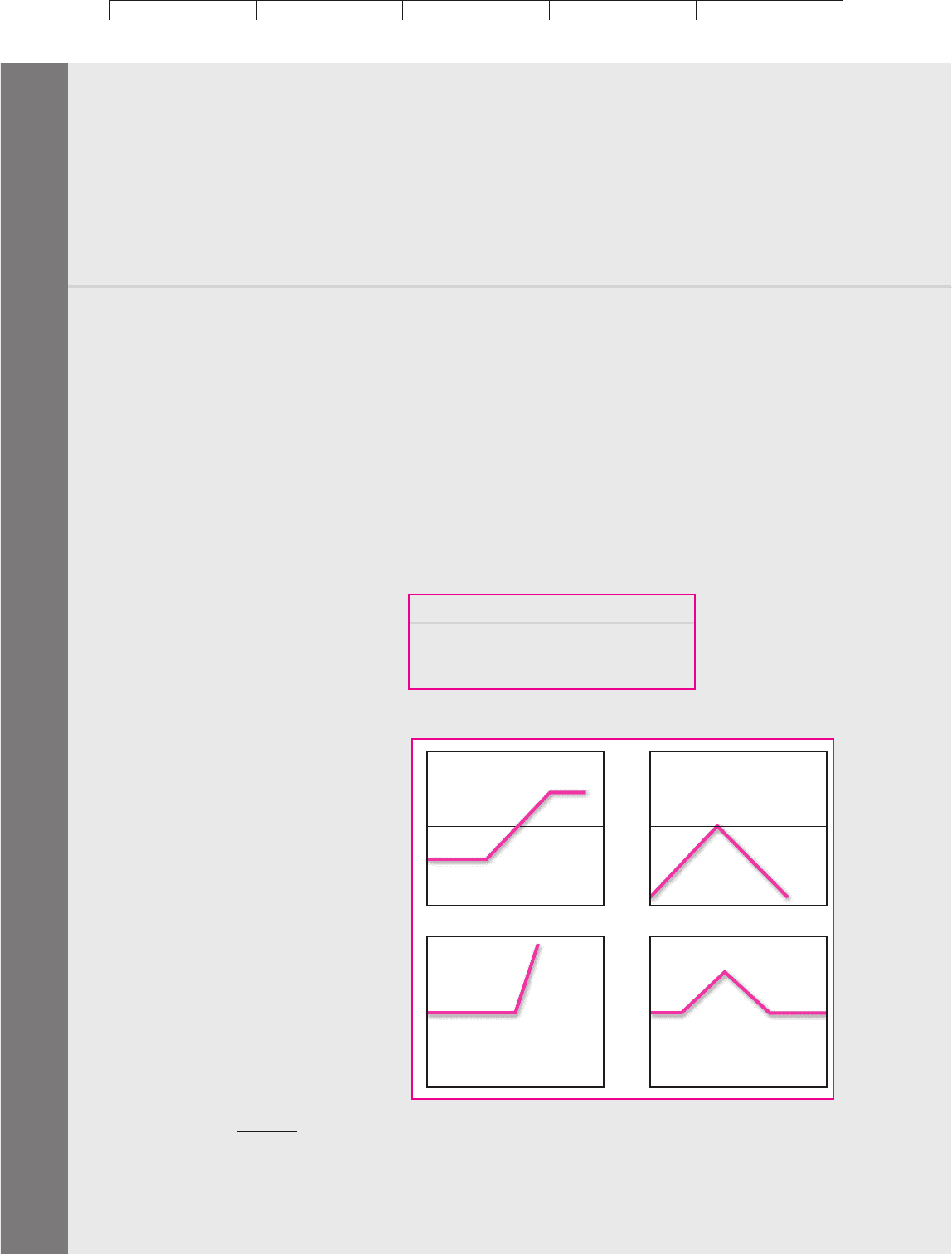
Brealey−Meyers:
Principles of Corporate
Finance, Seventh Edition
VI. Options 20. Understanding Options
© The McGraw−Hill
Companies, 2003
588 PART VI Options
22. You’ve just completed a month-long study of energy markets and conclude that energy
prices will be much more volatile in the next year than historically. Assuming you’re
right, what types of option strategies should you undertake? Note: You can buy or sell
options on oil-company stocks or on the price of future deliveries of crude oil, natural
gas, fuel oil, etc.
CHALLENGE
QUESTIONS
1. Figure 20.14 shows some complicated position diagrams. Work out the combination of
stocks, bonds, and options that produces each of these positions.
2. In 1988 the Australian firm Bond Corporation sold a share in some land that it owned
near Rome for $110 million and as a result boosted its 1988 earnings by $74 million. In
1989 a television program revealed that the buyer was given a put option to sell its share
in the land back to Bond for $110 million and that Bond had paid $20 million for a call
option to repurchase the share in the land for the same price.
18
a. What happens if the land is worth more than $110 million when the options
expire? What if it is worth less than $110 million?
b. Use position diagrams to show the net effect of the land sale and the option
transactions.
c. Assume a one-year maturity on the options. Can you deduce the interest rate?
d. The television program argued that it was misleading to record a profit on the sale
of land. What do you think?
3. Three six-month call options are traded on Hogswill stock:
Visit us at www.mhhe.com/bm7e
FIGURE 20.14
Some complicated position diagrams. See Challenge
Question 1.
Exercise Price Call Option Price
$90 $5
100 11
110 15
18
See Sydney Morning Herald, March 14, 1989, p. 27. The options were subsequently renegotiated.

Brealey−Meyers:
Principles of Corporate
Finance, Seventh Edition
VI. Options 20. Understanding Options
© The McGraw−Hill
Companies, 2003
CHAPTER 20 Understanding Options 589
Visit us at www.mhhe.com/bm7e
How would you make money by trading in Hogswill options? (Hint: Draw a graph
with the option price on the vertical axis and the ratio of stock price to exercise price on
the horizontal axis. Plot the three Hogswill options on your graph. Does this fit with
what you know about how option prices should vary with the ratio of stock price to ex-
ercise price?) Now look in the newspaper at options with the same maturity but differ-
ent exercise prices. Can you find any money-making opportunities?
4. Ms. Higden has been offered yet another incentive scheme (see Section 20.2). She will
receive a bonus of $500,000 if the stock price at the end of the year is $120 or more; oth-
erwise she will receive nothing.
a. Draw a position diagram illustrating the payoffs from such a scheme.
b. What combination of options would provide these payoffs? (Hint: You need to buy
a large number of options with one exercise price and sell a similar number with a
different exercise price.)

Brealey−Meyers:
Principles of Corporate
Finance, Seventh Edition
VI. Options 21. Valuing Options
© The McGraw−Hill
Companies, 2003
CHAPTER TWENTY-ONE
590
VALUING OPTIONS

Brealey−Meyers:
Principles of Corporate
Finance, Seventh Edition
VI. Options 21. Valuing Options
© The McGraw−Hill
Companies, 2003
IN THE LAST chapter we introduced you to call and put options. Call options give the owner the right to
buy an asset at a specified exercise price; put options give the right to sell. We also took the first step
toward understanding how options are valued. The value of a call option depends on five variables:
1. The higher the price of the asset, the more valuable an option to buy it.
2. The lower the price that you must pay to exercise the call, the more valuable the option.
3. You do not need to pay the exercise price until the option expires. This delay is most valuable when
the interest rate is high.
4. If the stock price is below the exercise price at maturity, the call is valueless regardless of whether
the price is $1 below or $100 below. However, for every dollar that the stock price rises above the
exercise price, the option holder gains an additional dollar. Thus, the value of the call option in-
creases with the volatility of the stock price.
5. Finally, a long-term option is more valuable than a short-term option. A distant maturity delays the
point at which the holder needs to pay the exercise price and increases the chance of a large jump
in the stock price before the option matures.
In this chapter we show how these variables can be combined into an exact option-valuation
model—a formula we can plug numbers into to get a definite answer. We first describe a simple way
to value options, known as the binomial model. We then introduce the Black–Scholes formula for valu-
ing options. Finally, we provide a checklist showing how these two methods can be used to solve a
number of practical option problems.
The only feasible way to value most options is to use a computer. But in this chapter we will work
through some simple examples by hand. We do so because unless you understand the basic princi-
ples behind option valuation, you are likely to make mistakes in setting up an option problem and
you won’t know how to interpret the computer’s answer and explain it to others.
In the last chapter we introduced you to the put and call options on AOL stock. In this chapter we
will stick with that example and show you how to value the AOL options. But remember why you need
to understand option valuation. It is not to make a quick buck trading on an options exchange. It is
because many capital budgeting and financing decisions have options embedded in them. We will
discuss a variety of these options in subsequent chapters.
591
21.1 A SIMPLE OPTION-VALUATION MODEL
Why Discounted Cash Flow Won’t Work for Options
For many years economists searched for a practical formula to value options until
Fisher Black and Myron Scholes finally hit upon the solution. Later we will show
you what they found, but first we should explain why the search was so difficult.
Our standard procedure for valuing an asset is to (1) figure out expected cash
flows and (2) discount them at the opportunity cost of capital. Unfortunately, this is
not practical for options. The first step is messy but feasible, but finding the oppor-
tunity cost of capital is impossible, because the risk of an option changes every time
the stock price moves,
1
and we know it will move along a random walk through the
option’s lifetime.
1
It also changes over time even with the stock price constant.

Brealey−Meyers:
Principles of Corporate
Finance, Seventh Edition
VI. Options 21. Valuing Options
© The McGraw−Hill
Companies, 2003
When you buy a call, you are taking a position in the stock but putting up less
of your own money than if you had bought the stock directly. Thus, an option is al-
ways riskier than the underlying stock. It has a higher beta and a higher standard
deviation of return.
How much riskier the option is depends on the stock price relative to the exer-
cise price. A call option that is in the money (stock price greater than exercise price)
is safer than one that is out of the money (stock price less than exercise price). Thus
a stock price increase raises the option’s price and reduces its risk. When the stock
price falls, the option’s price falls and its risk increases. That is why the expected
rate of return investors demand from an option changes day by day, or hour by
hour, every time the stock price moves.
We repeat the general rule: The higher the stock price is relative to the exercise
price, the safer is the call option, although the option is always riskier than the
stock. The option’s risk changes every time the stock price changes.
Constructing Option Equivalents from Common Stocks and Borrowing
If you’ve digested what we’ve said so far, you can appreciate why options are hard
to value by standard discounted-cash-flow formulas and why a rigorous option-
valuation technique eluded economists for many years. The breakthrough came
when Black and Scholes exclaimed, “Eureka! We have found it!
2
The trick is to set
up an option equivalent by combining common stock investment and borrowing.
The net cost of buying the option equivalent must equal the value of the option.”
We’ll show you how this works with a simple numerical example. We’ll travel
back to the end of June 2001 and consider a six-month call option on AOL Time
Warner (AOL) stock with an exercise price of $55. We’ll pick a day when AOL stock
was also trading at $55, so that this option is at the money. The short-term, risk-free
interest rate was a bit less than 4 percent per year, or about 2 percent for six months.
To keep the example as simple as possible, we assume that AOL stock can do
only two things over the option’s six-month life: either the price will fall by a quar-
ter to $41.25 or rise by one-third to $73.33.
If AOL’s stock price falls to $41.25, the call option will be worthless, but if the
price rises to $73.33, the option will be worth . The possible
payoffs to the option are therefore
$73.33 ⫺ 55 ⫽ $18.33
592 PART VI
Options
2
We do not know whether Black and Scholes, like Archimedes, were sitting in bathtubs at the time.
3
The amount that you need to borrow from the bank is simply the present value of the difference be-
tween the payoffs from the option and the payoffs from the .5714 shares. In our example, amount bor-
rowed ⫽ (55 ⫺ .5714 ⫻ 55)/1.02 ⫽ $23.11.
1 call option $0 $18.33
Stock Price ⫽ $73.33Stock Price ⫽ $41.25
Now compare these payoffs with what you would get if you bought .5714 AOL
shares and borrowed $23.11 from the bank:
3
.5714 shares $23.57 $41.90
Repayment of ⫺23.57 ⫺23.57
Total payoff $ 0 $18.33
loan ⫹ interest
Stock Price ⫽ $73.33Stock Price ⫽ $41.25
